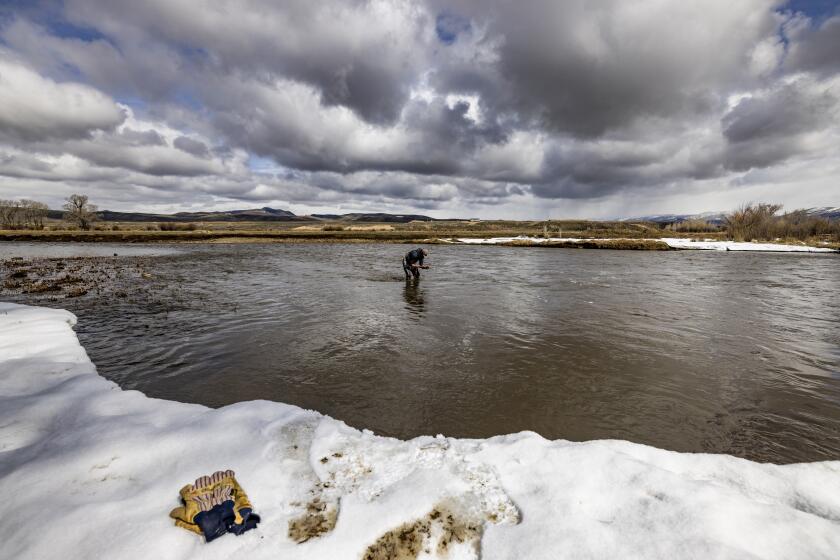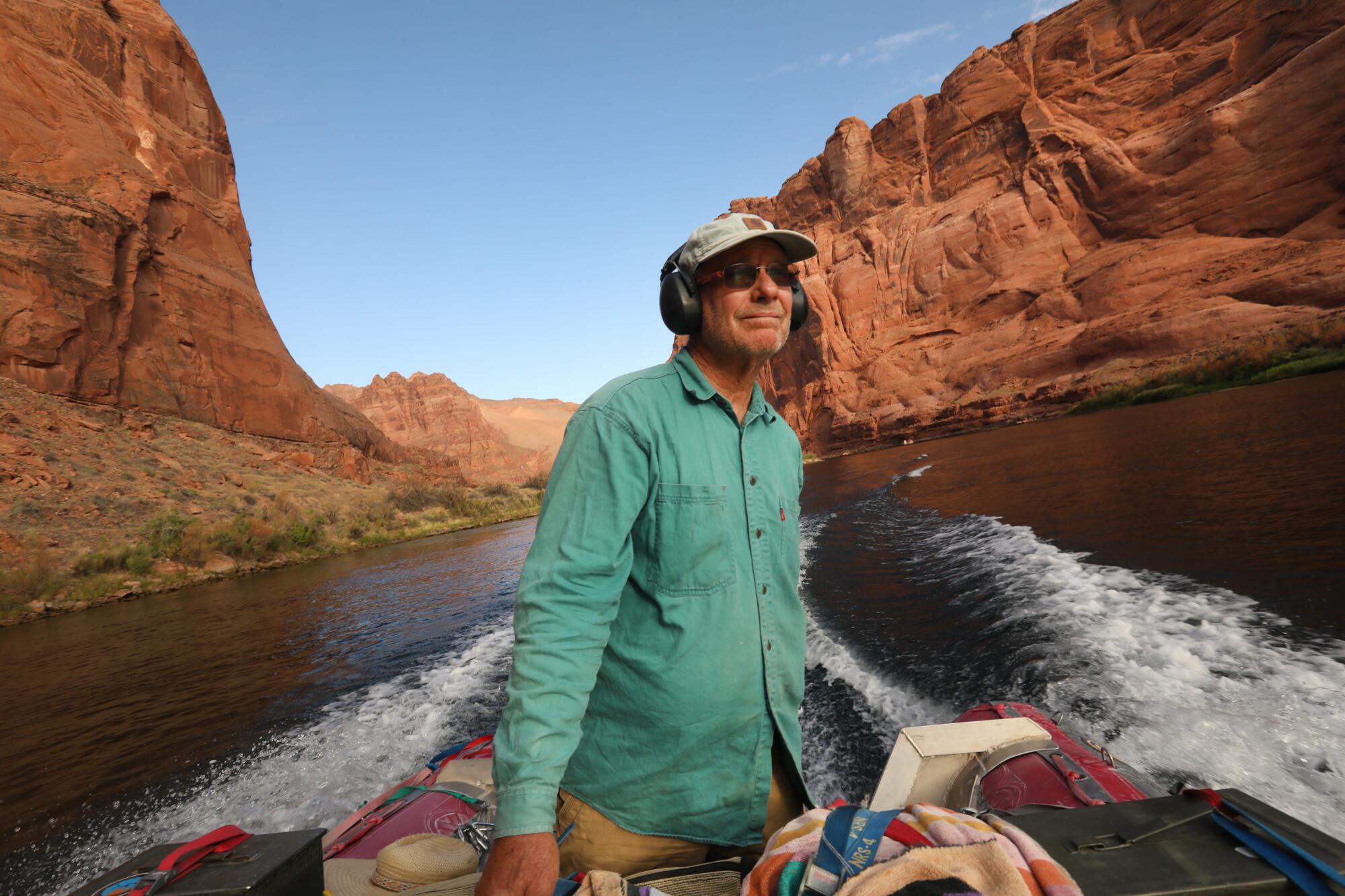
- Share via
LAKE POWELL, Utah — Muddy water whizzed past as John Weisheit steered a motorboat upstream in the Colorado River. He revved the engine as the boat sped around a bend and up a riffle.
All along the river’s banks, giant mounds of dried mud and silt rose taller than houses — sediment that settled in Lake Powell over decades and has been left exposed by the reservoir’s retreating waters.
Suddenly, the water turned rough around Weisheit and his four passengers. The rapids rose up in waves. The boat descended in a churning brown trough and hit bottom, then popped up, throwing the passengers to the front.
“This is really gnarly,” Weisheit said. “I don’t know if I’m willing to flip a boat for this.”
Weisheit said he thought he knew this part of the Colorado River, like so many other stretches where he has guided expeditions over the last four decades. But this portion of the river just upstream from Lake Powell has been transformed by the reservoir’s decline.
“I’m totally cognizant of the fact that 40 million people need this river. But unfortunately, this river can’t sustain 40 million people. And that’s the problem,” Weisheit said. “We need to respect the river for what it is, and we’re not doing that.”
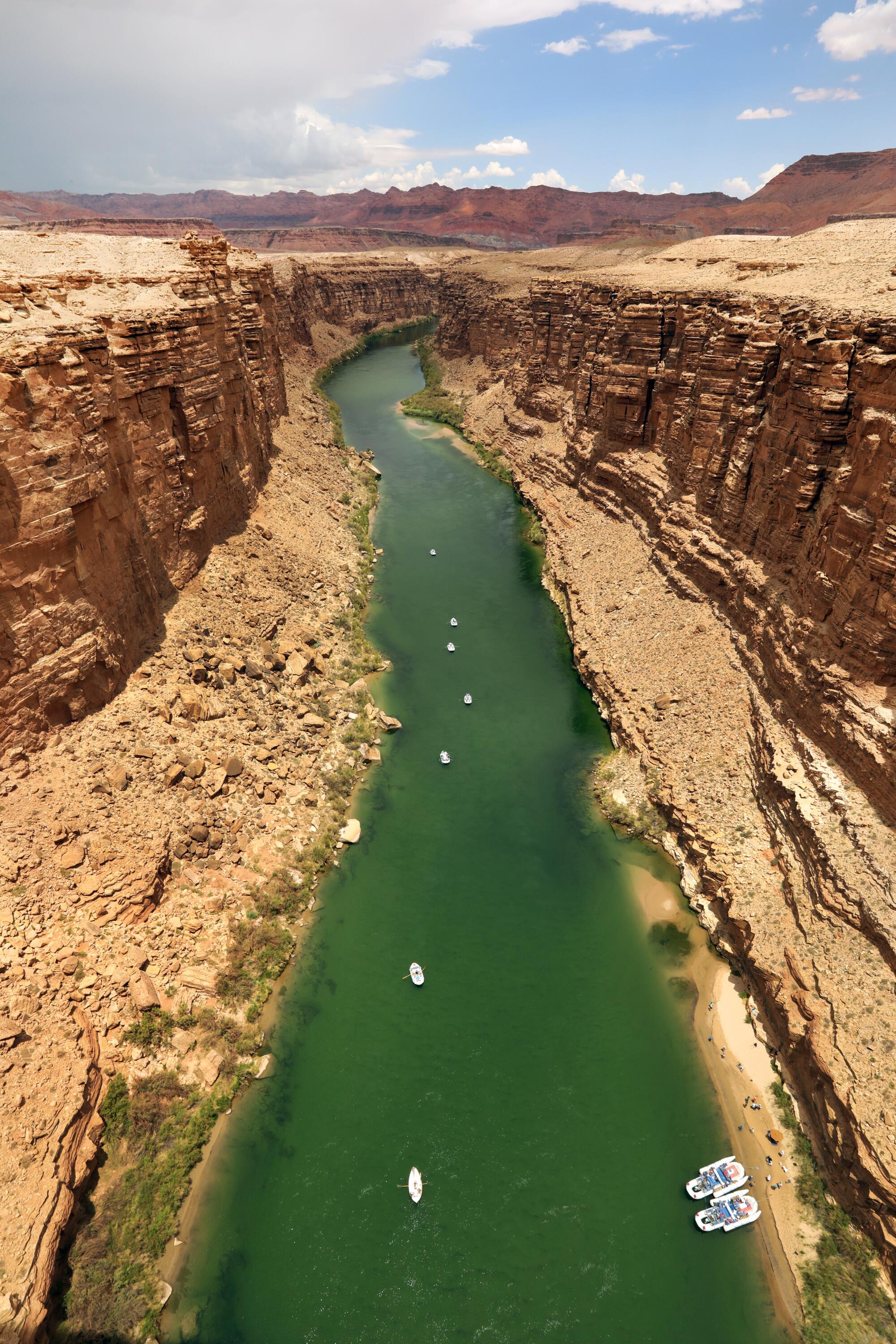
The signing of the Colorado River Compact a century ago divided the water among seven states, but the system of allocations and rights promised far more water than the river could provide.
Weisheit said he has seen the water deficit mounting for years, and now the river is approaching a breaking point, its reservoirs at the lowest levels since they were filled, and continuing to fall.
“We’re backed into a corner,” Weisheit said. “With or without climate change, this would still happen. Climate change just makes it worse and more severe.”
Weisheit, an environmental activist and veteran river guide, said he has long been convinced that the crisis would come because the allocation system has left supply and demand perpetually out of balance. The pattern of depletion has worsened as the river’s flow has shrunk during 23 years of drought compounded by rising temperatures.
Weisheit said he feels frustrated and angry about how the river has been “enslaved,” overallocated and mismanaged for decades.
“We’re going to be on the short end of the stick eventually. And it’s happening right now,” Weisheit said. “It’s falling apart.”
After encountering the new rapids in the shifting sediment, Weisheit said going farther upstream could be dangerous. He turned around and headed back downstream.
“This is nothing but reservoir sediment over here,” Weisheit said. “It’s totally different. I’m shocked.”

Cliffs of dried reservoir silt towered over the river. On top of these formations, tumbleweeds sprouted in patches. Now and then, a piece of the mud cliffs broke off and fell into the river like a collapsing glacier, releasing a puff of dust.
Lake Powell has shimmered between red canyon walls since Glen Canyon Dam was completed in the 1960s. But over the last two years, the reservoir’s level has dropped more than 50 feet. Its surface now sits less than 35 feet away from a point where the dam would no longer generate power.
Colorado River in Crisis is a series of stories, videos and podcasts in which Los Angeles Times journalists travel throughout the river’s watershed, from the headwaters in the Rocky Mountains to the river’s dry delta in Mexico.
The federal managers of Glen Canyon Dam are trying to boost the reservoir by reducing the amount of water they release downstream until the spring runoff arrives. They’ve warned they may need to further cut back water releases.
If the reservoir keeps dropping beyond a critical threshold, the main intakes would no longer be usable and water would flow only through the dam’s lower bypass tubes, which have reduced capacity. That could lead to less water passing downstream, shrinking the river’s flow in the Grand Canyon and accelerating the decline of Lake Mead toward “dead pool” — the point at which water would no longer pass through Hoover Dam to Arizona, California and Mexico.
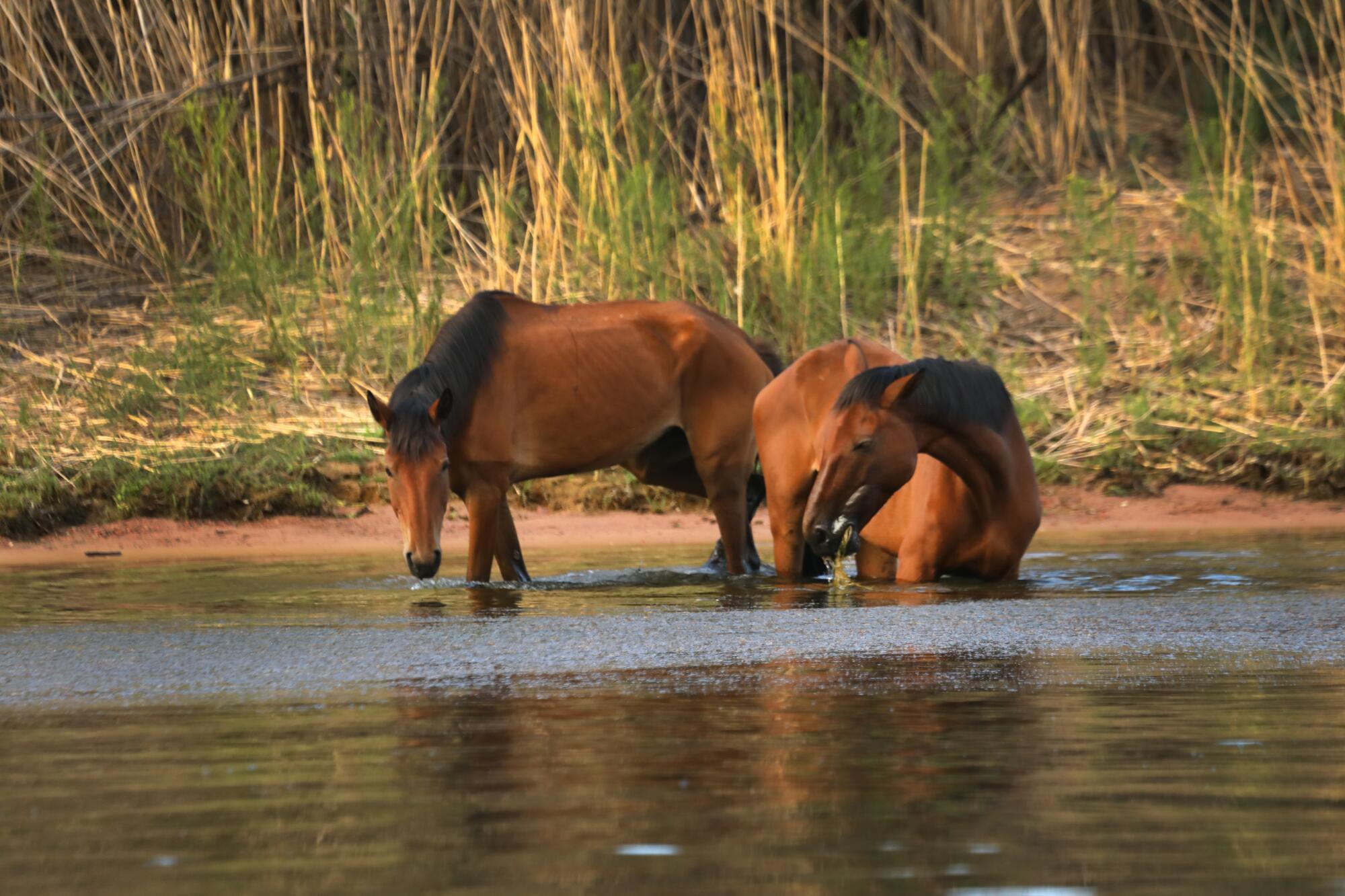
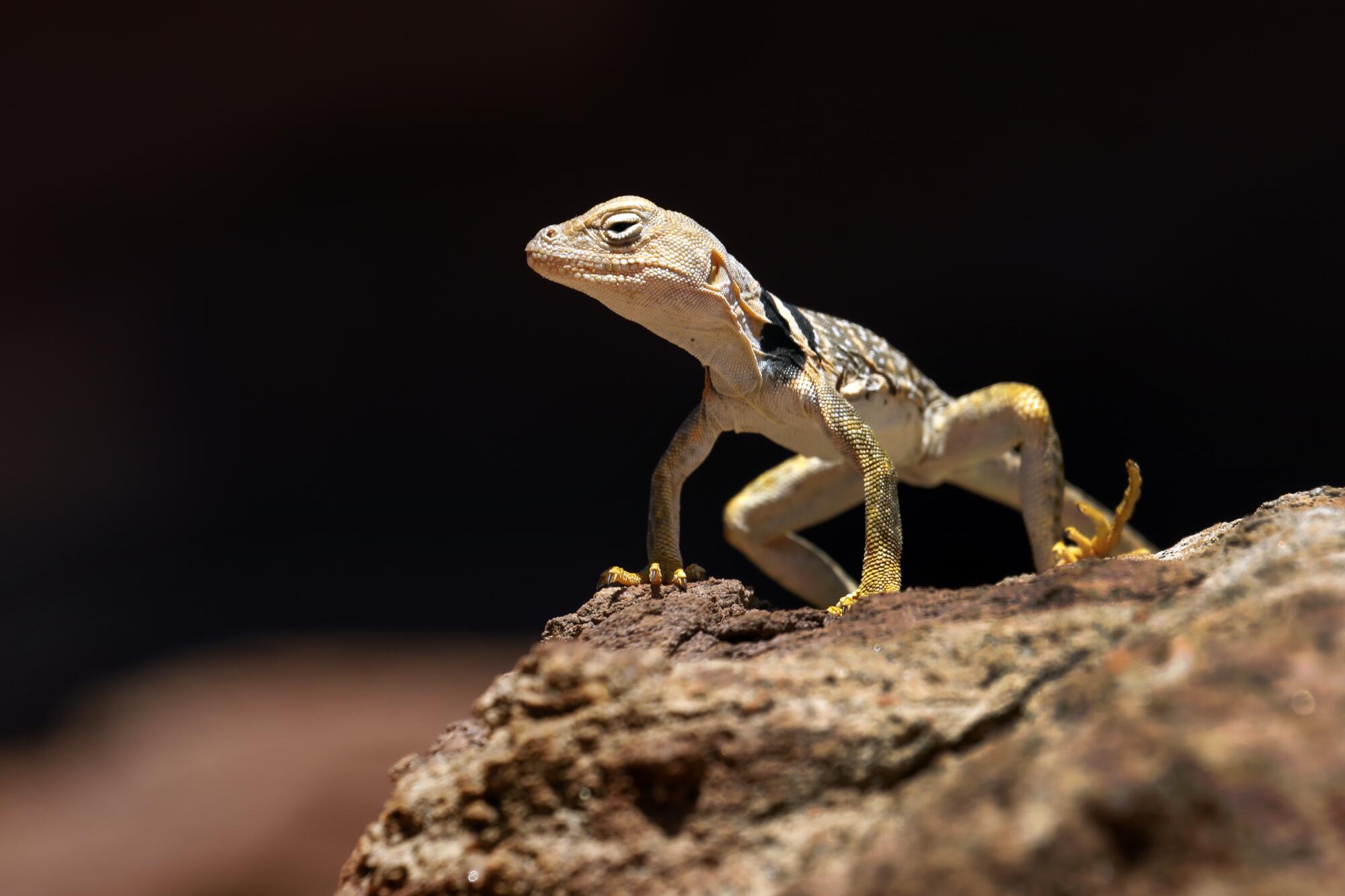
The danger of reaching a catastrophic scenario in which the water runs out is prompting urgent discussions among public officials about how to respond. Despite widespread agreement on the need to cut water use, representatives of states and water agencies have yet to agree on how the reductions should be divided.
Weisheit said he blames the region’s water managers, who years ago understood the gap between supply and demand but largely ignored warnings from scientists and failed to balance the water budget. Weisheit has written that it’s time to change the “baseline misinformation in the 1922 Colorado River Compact to reflect reality.” He says the reductions would have been much more manageable if had they been implemented sooner.
“Nobody did anything to prevent this day of reckoning from coming,” he said. “So the imbalance is going to sink the ship.
“This is a system that doesn’t work,” he said.
Weisheit, 68, lives in Moab, Utah, and has spent his life boating and exploring the river. He is co-founder of the group Living Rivers and works with the Waterkeeper Alliance, serving as the Colorado Riverkeeper, the organization’s one representative in the watershed.
Weisheit grew up in Whittier, and his family later moved to Phoenix. His father worked for General Electric and regularly took the family to visit power plants and dams.
As a boy, Weisheit started water-skiing on Lake Havasu. He first visited Lake Powell on a family boating trip in 1972, when he was 18, and enjoyed skiing across the clear, blue water. The following year, the lake level rose dramatically, and when Weisheit returned, he saw that the rising water had covered trees and ancient Indigenous ruins. He saw beavers that seemed to be searching for their drowned habitat.
“I was horrified. That’s when the light went on,” Weisheit said.
His views about the river and the dam were shaped by his years guiding trips on the river, including expeditions with scientists. He and his wife, Susette, also a river guide, were married at the confluence of the Green and Colorado rivers.
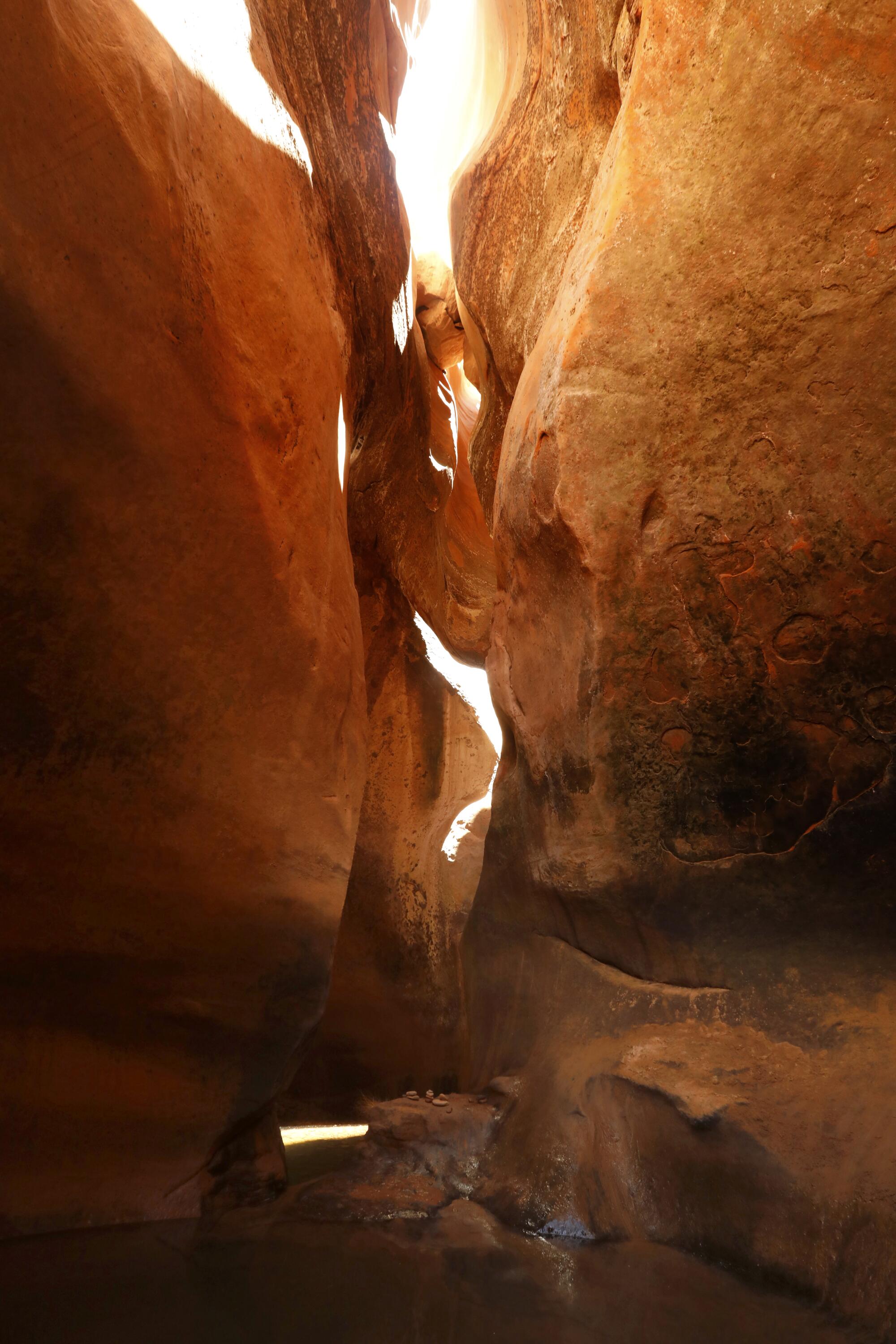
In recent years, Weisheit has condemned the status quo water management system, filed lawsuits against the government, opposed Utah’s plans for a new 140-mile water pipeline to take more from the river, and argued that Glen Canyon Dam should be decommissioned to restore the river to a more natural state.
Weisheit points out that from the beginning, some well-informed people were convinced that building Glen Canyon Dam was a mistake, and that there wasn’t enough water to meet all the demands. He cites the 1954 congressional testimony of California water lawyer Northcutt Ely opposing the dam.
The Colorado River is approaching a breaking point, its over-tapped reservoirs dropping. Years of drying have taken a toll at the river’s source in the Rockies.
One of Weisheit’s mentors was David Brower, the late leader of the Sierra Club who lamented losing a “living canyon of incredible, haunting beauty,” and who offered him advice about how to push for change through activism.
Sometimes on river trips, Weisheit has reread the author Edward Abbey’s condemnations of the dam and his account of boating through a pristine Glen Canyon before it was flooded. Abbey called it “an Eden, a portion of the earth’s original paradise.”
“I’m totally cognizant of the fact that 40 million people need this river. But unfortunately, this river can’t sustain 40 million people. And that’s the problem.”
— John Weisheit

After a night camping by the river, Weisheit guided the boat downstream while the canyon walls glowed red in the rising sun. Pelicans soared past and landed on a sandbar.
When the boat reached a point where the current disappeared, the water’s color changed from brown to translucent green. A thick mat of driftwood floated in the still water of Lake Powell.
Nearby, water skiers skimmed past. Houseboats motored slowly beside the towering canyon walls.
As the reservoir has declined, portions of Glen Canyon that were underwater for decades are reemerging.
In one side canyon, the bare, pale limbs of long-drowned cottonwood trees protrude from the water like freshly unearthed fossils.
In other narrow canyons, water seeps from the rock walls, nourishing natural “hanging gardens” of ferns and orchids.
“Ecologically, it’s a vibrant river. It’s one of the most vibrant I’ve ever seen,” Weisheit said. “In my lifetime, I have seen this change. And that’s profound because nature doesn’t work that quick, unless there’s something goofy.”
“It’s sad because I know this is not what the Colorado River is supposed to look like. Nature would brown this up a bit and put some driftwood in it, lots of sand.”
— John Weisheit
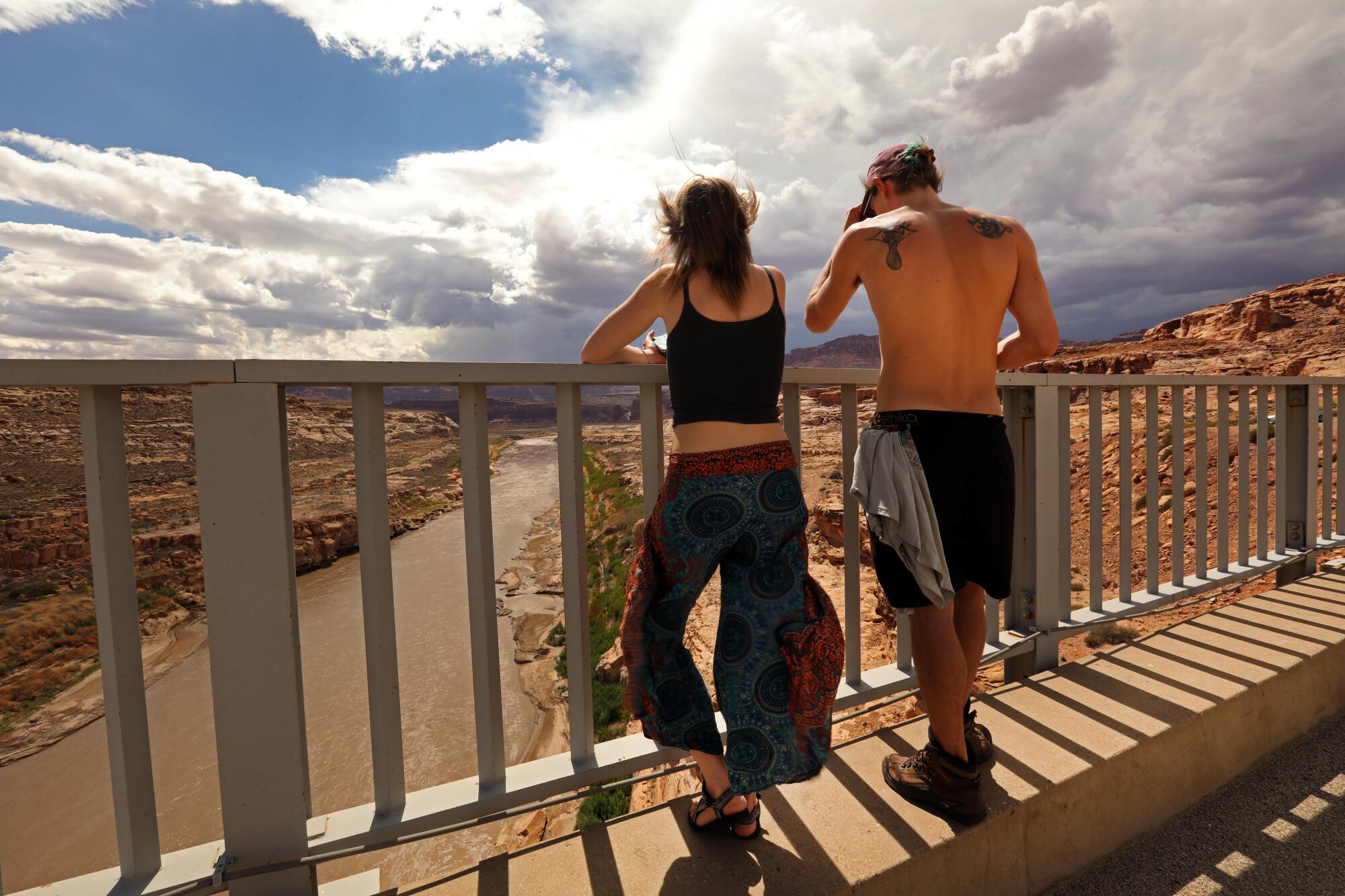
Weisheit drove to Hite Overlook and stood on a bluff overlooking a part of the reservoir that has dried up. Where a marina once floated, a silt-clogged canyon floor spreads out along the river.
He said he thinks the increasingly sediment-filled reservoir represents a failed attempt at controlling nature, and a problem that will bring major costs — just like the perpetual overuse of water.
A recent federal survey found Lake Powell has lost nearly 6.8% of its water-storing capacity due to the accumulation of sediments in the reservoir bottom since the 1960s. Weisheit said he worries not only about the lack of a plan to remove sediment, but also the risks the dam would face in a flood, which could be larger than the one that filled the reservoir to the brim in 1983.
As part of the federal government’s newly launched process of revising the rules for dealing with shortages, Weisheit and other activists have presented a list of recommendations. They’ve said mandatory water cuts are necessary and that water deliveries should be adjusted to match the river’s flow. They’ve also urged the Bureau of Reclamation to look beyond the current drought and prepare for more intense floods, saying in a letter that in the coming decades, “adaptation to global warming must include the impacts of large precipitation events.”
“All our planning is short-sighted, and it’s not sustainable and it’s not resilient,” Weisheit said. “It should be changed, but they’re reluctant to change.”
On a nearby stretch of river that used to be underwater in Lake Powell, whitewater rafters stepped out of boats onto a steep bank of dried silt.
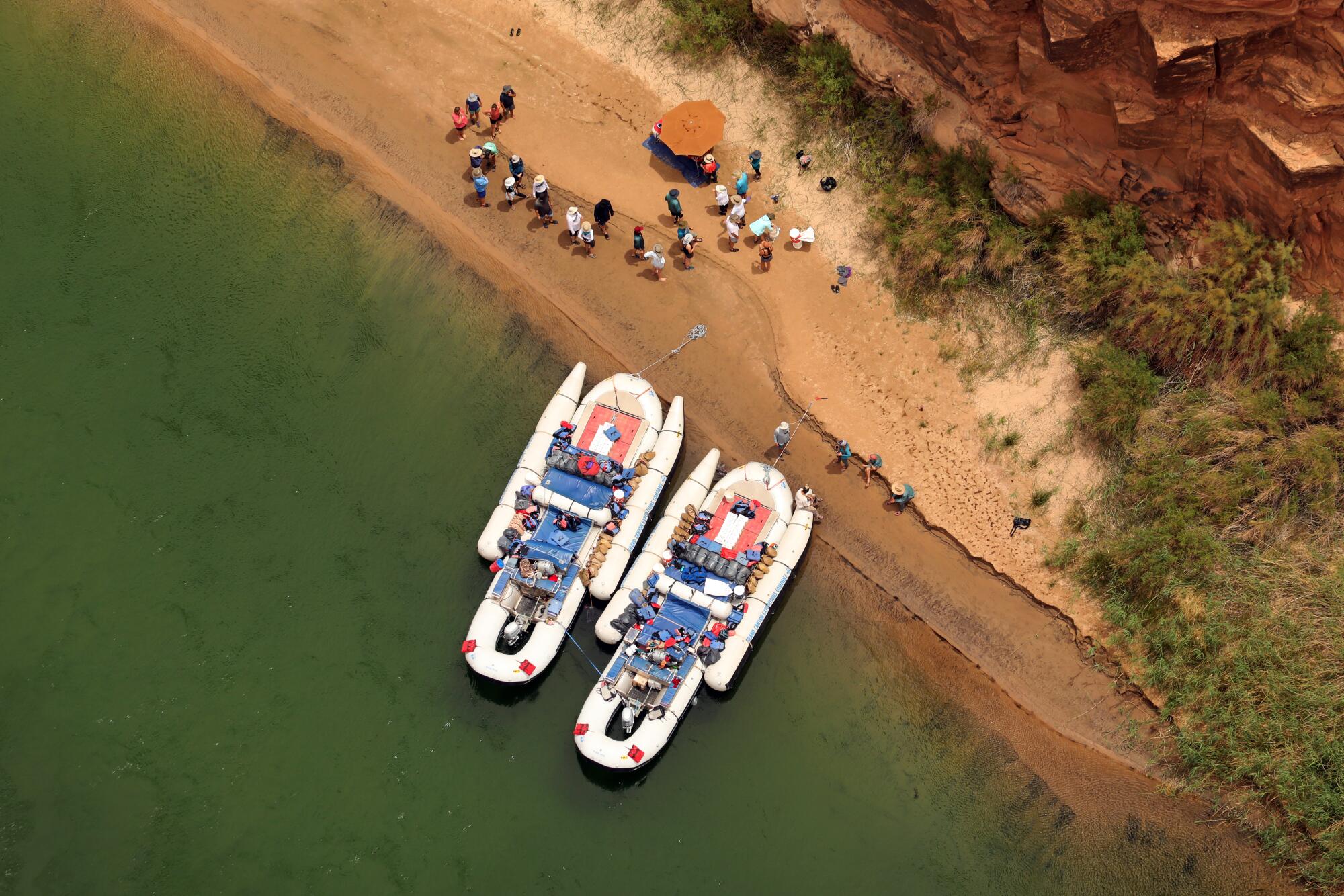
Guides hauled a raft uphill using a rope tied to a truck, pushing the boat by rolling it on tubes. The guides have started calling the thick layer of accumulated sediment the Dominy Formation, after Floyd Dominy, the flamboyant Bureau of Reclamation commissioner who championed the dam’s construction.
Large cracks had formed in the dirt, and the guides said they didn’t know how much longer the bank might hold before it collapsed.
“This just looks so unsafe,” Weisheit said, inspecting a gaping crack in the ground.
The next morning, Weisheit put in the boat at Lees Ferry and headed upstream toward Glen Canyon Dam. Because the dam traps silt, the river downstream from it flows clear and green.
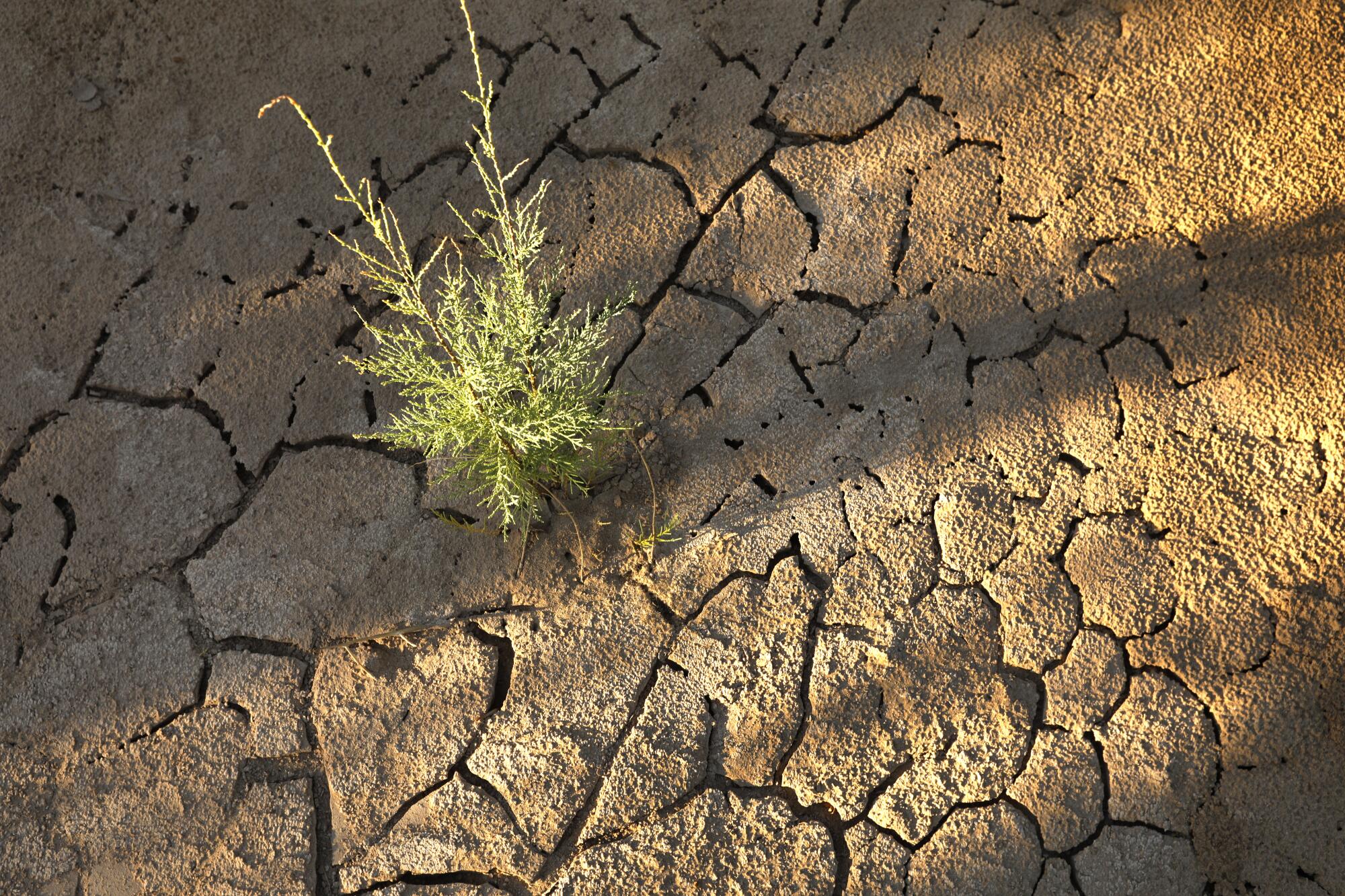
“It’s sad because I know this is not what the Colorado River is supposed to look like,” Weisheit said. “Nature would brown this up a bit and put some driftwood in it, lots of sand.”
He said he’s certain that the river will return to its natural state someday. The longer the dam remains operational, he said, the tougher restoration will be.
Last year, Weisheit and other environmentalists announced a contest, inviting engineers and engineering students to submit proposals for reengineering Glen Canyon Dam and rewilding the river. That would fit with Weisheit’s long-standing proposal for decommissioning the dam. Other activists have for years supported a similar proposal called Fill Mead First, which would gradually drain Lake Powell and store the water downstream in Lake Mead.
“I want a different system. Because this is a system that comes to an end. This is not a forever system,” Weisheit said. “It should be removed incrementally, and there should be a plan.”
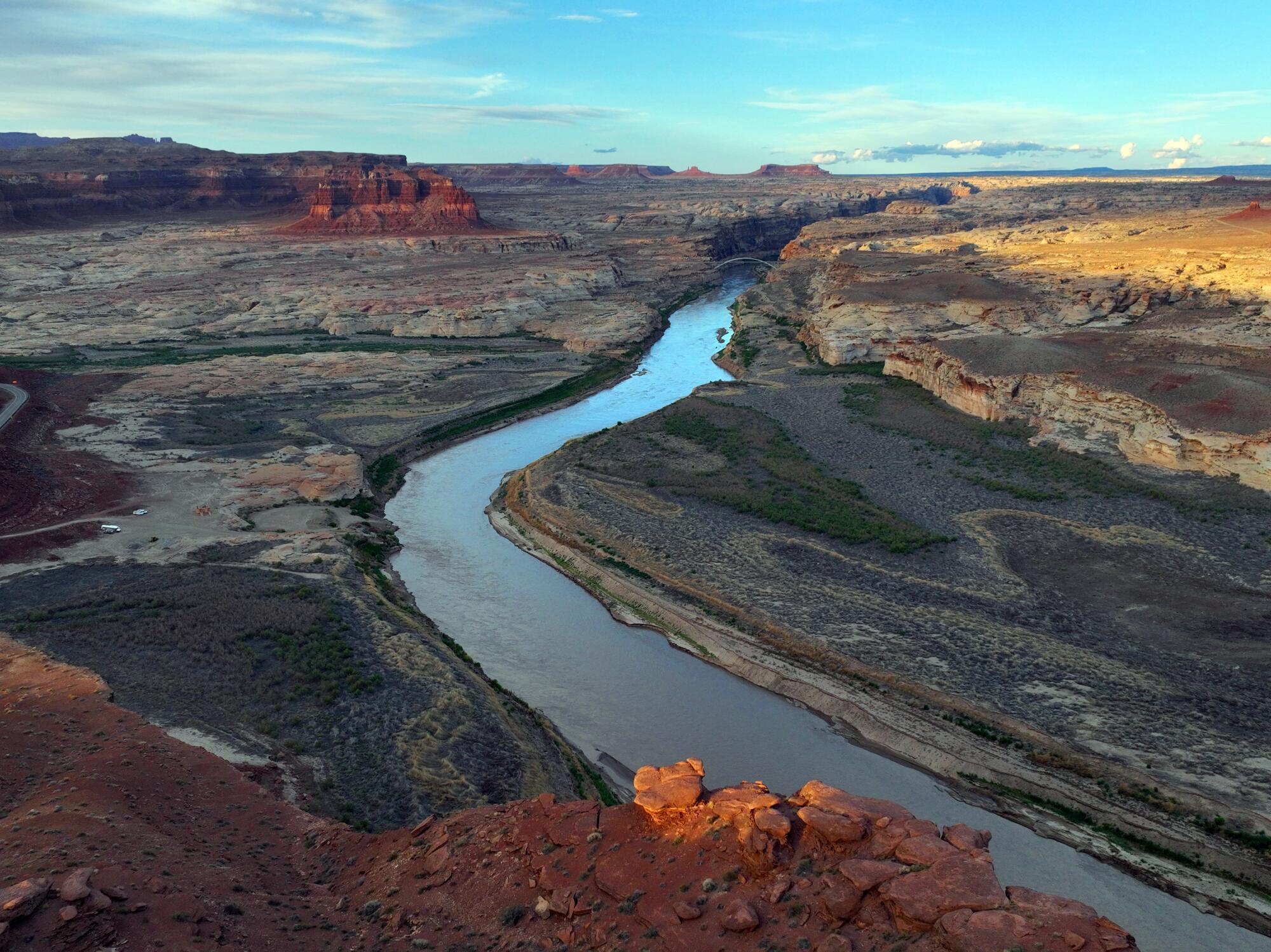
His stance is squarely at odds with the predominant position of water management officials, who say the dam continues to serve its purposes of storing water, generating power and providing flood protection. But Weisheit said the dropping water levels have revealed the dam’s limitations.
“It works until it doesn’t,” he said. “Now we know it’s a failure.”
Weisheit motored close to the dam. He cut the engines and let the boat drift to a thicket on the bank. He looked up at the dam’s towering concrete face with an expression of disgust.
“I see vanity, hubris. I see arrogance,” Weisheit said. “We’re not respecting nature. We’re not. It has limits.”

